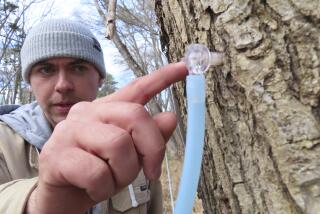New beer made by monks arrives in the U.S.
At the Monastero di San Benedetto in central Italy, the monks understand the potential of the U.S. beer market — because these monks are American.
“I knew the difference between craft beer and run-of-the-mill factory beer,” says Father Benedict Nivakoff of his life before committing himself to monastic life. He is from Connecticut, but you’d hardly know it from the traditional black robe, long-growth beard and intonation, which is a result of his polylingualism.
Monks have a storied history of brewing beer, but in Italy the industry has always been wine. Today, these Benedictine monks are brewing and exporting Birra Nursia to the U.S. as a means of fulfilling the Rule of Saint Benedict, which requires self-sufficiency through work.
This April, Birra Nursia’s two beers, a blond ale and a Belgian strong ale, hit the U.S. market. Customers order on the monastery website and, shortly thereafter, beer arrives at their door.
“For us, it was really important that the monks do everything,” says Father Benedict. In Belgium, where making beer in monasteries has been a part of life for centuries, some operations have become commercialized. “Most of the monasteries have gone big and make so much beer that they can export it all over the world,” he says.
In order to integrate small-scale brewing within the rigid demands of monastic life, the monks of Norcia visited their Trappist brothers at small monastic breweries across Belgium. “Our life is mostly centered around prayer,” says Father Benedict, “so we get up at 3:30 in the morning, we pray seven times a day, we’re in and out of the church every hour — there isn’t a lot else we can do, besides the brewery.”
The monks don’t hire outside help, so they need to closely manage the beer. “One of the ways we can be successful is to have very few middlemen,” says Father Benedict. After the monks brew and bottle the beer in Norcia, they send it by container ship to their distributor, Holiday Wine Cellar, in Southern California. From the distributor it goes directly to your door. “We have control over every step of the process,” he adds.
So how much of the beer they make do they actually get to drink?
“Not a small amount,” says Father Benedict with a laugh. “We have very high standards, so a lot of things that don’t meet our standards come to the monks’ table.”
Tap into the Brotherhood with these monk beers, available in California.
Birra Nursia Extra by Monastero di San Benedetto (Norcia, Italy) Belgian strong dark ale, 10% alcohol by volume (ABV)
If holy contact is paramount, Birra Nursia delivers the most monk for your buck. From the hilltop monastery in central Italy, there are no laymen involved in the production or packaging of the beer, and no retailers or bartenders between you and this Benedectine brew. Available online.
Chimay Blue Grand Reserve, by Abbaye Notre-Dame de Scourmont (Chimay, Belgium) Belgian strong dark ale, 9% ABV
Chimay is the most commercial of the Authentic Trappist Product beers, a designation by the International Trappist Assn. (ITA) that requires a monastic brewery to meet several qualifications. Coursing through a broad distribution of American grocery stores, Chimay offers an entry point to monk beer for drinkers in every geographic reach. Available at Trader Joe’s.
Ovila Abbey Saison by Sierra Nevada Brewing Co. (Chico, CA) Styles and ingredients vary seasonally
For a uniquely Californian perspective on monk beer, Sierra Nevada brews the Ovila Abbey Ales series in collaboration with the monks of Abbey of New Clairvaux. These Cistercian brothers harvest fruit for the beer from their orchards in Vina, Calif., where they also tend vineyards. Available at Beverage Warehouse.
Gregorius by Stift Engelszell (Engelhartszell, Austria) Belgian strong dark ale, 9.7% ABV
Stift Engelszell became the eighth certified Trappist brewery in 2012 and the only European representative outside the Low Countries. On the banks of the Danube in northern Austria, the Trappist monks brew Gregorius with regional hops and local honey. Available at Total Wine & More.
Orval by Abbaye de Notre-Dame d’Orval (Villers-devant-Orval, Belgium) Belgian strong dark ale, 6.2% ABV
Unlike other monastic breweries, which offer two or more styles of beer, Orval produces only one beer for the public. With lighter alcohol and a gentler flavor than many other Trappist beers, Orval is a very palatable example of monk-made beer coming from an 11th century monastery. Available at Ramirez Liquor.
Trappistes Rochefort 8 by Abbaye Notre-Dame de Saint-Rémy (Rochefort, Belgium) Belgian strong dark ale, 9.2% ABV
Rochefort beer is made with relatively hard water from a nearby spring, contributing to the distinctive character of this beer. The green cap Rochefort 8 is more complex than Rochefort 6 but not as intense or high in alcohol as Rochefort 10. Available at Vendome Wine & Spirits.
Westmalle Trappist Tripel by Abdij der Trappisten van Westmalle (Malle, Belgium) Belgian tripel, 9.5% ABV
Like other Trappist breweries with large production, the monks at Westmalle oversee operations, allocating funds and maintaining core values, but do not physically brew the beer. Westmalle launched the tripel in 1934 and the recipe has remained largely unchanged since the 1950s. Available at BevMo.
La Trappe Quadrupel by de Koningshoeven (Berkel-Enschot, Netherlands) Quadrupel, 10% ABV
The Koningshoeven brewery has a contentious past regarding monk involvement. When a commercial Dutch brewery took over operations in 1999, La Trappe beers no longer met the requirements of the ITA to be an Authentic Trappist Product. When monks returned to the scene a few years later, the brewery won its designation back. Available at Valley Beverage Co.
ALSO:
Farmers market report: Cherries are in season. We have recipes
A new meal-in-a-bottle wants to be the new Soylent. With less carbs!
More to Read
Eat your way across L.A.
Get our weekly Tasting Notes newsletter for reviews, news and more.
You may occasionally receive promotional content from the Los Angeles Times.






